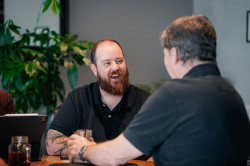How to secure your follow-up contract as a freelancer after the test phase - in just 4 weeks
The test phase: No contract. No safety net. No hidden costs. A freelancer is contacted by a potential client via Freelancing.hk. The conversation is going well, the chemistry is right. Then comes the sentence: “Let’s start with a small test task – before we move into the big collaboration.”
The freelancer hesitates. It sounds like mistrust. Like "prove it for free first." Like one of those jobs that ends nowhere. So he declines – politely but firmly. He never hears from that client again. The test phase was over before it even began.
Sound harsh? Yes. But situations like this happen every day. Because the rules of the game often remain unspoken during the test phase. Because many freelancers don´t know how to use them strategically – instead of feeling at the mercy of others.
But every test phase contains a real opportunity: to build trust, to demonstrate your position – and to almost guarantee follow-up business. This 4-week plan shows you how to do it. Without pushing. Without bragging. With clarity, strategy, and presence.
Week 1: How to build trust in the first days of the test phase
Those who only take on the execution are quickly overlooked. The first week determines whether you´re perceived as a person or merely a resource.
Introduce yourself actively. Not with a PDF attachment, but as a short message for a 15-minute conversation: “I would like to briefly introduce myself personally – 15 minutes, so that we can immediately clarify what a top result would be for you.”
Ask directly: "What would be a real hit for you?" This question makes it clear that you´re not thinking about yourself, but rather about the benefits for the customer. Clarify how communication will take place. Email? Weekly check-in? Clarifying this early on eliminates friction. And: Offer a short weekly status update – proactive, concise, and focused on impact.
Week 2: How to turn your work into a wow experience
Now´s your chance to make your first visible mark. Don´t just deliver, deliver something that will stick. For example, a smart workflow suggestion that saves time. Or a mini-graphic that simplifies complex information. Nothing fancy—but something that shows: "I´m thinking along!"
Explain not just what you´ve done—but why. And summarize your progress clearly—ideally: half a page with three bullet points. You don´t just control the project. You control how it´s perceived.
Week 3: From freelancer to sparring partner – this is how positioning works
Now it´s all about attitude. You don´t just want to react, you want to actively shape things. Analyze the project: What´s going well? Where is there potential? Be objective without being judgmental. Think along with others—not overthinking them.
Share learnings from other client projects: "X has proven successful in similar setups. Would that be feasible here?"
And then: Ask deep questions. Not small talk. But questions that make the customer fall silent for a moment – because you´re hitting on something.
Week 4: Strategically to the follow-up order – without pushing
Now it´s important to set the course. Naturally. Clearly. On an equal footing. Suggest a final meeting: “Let’s briefly combine a review and a look ahead – how did it go, what would be a sensible next step?”
Now it´s important to set the course. Naturally. Clearly. On an equal footing. Prepare a short presentation: 2-3 slides or 3 points for the call – what you´ve achieved, what´s still open, what you´re proposing. Be specific:
- Option A: 2 weeks of support for handover
- Option B: Continuation with a focus on [XY]
- Option C: Selective support for [XY]
Don´t sell. Offer. With attitude.
What remains – and what counts
Maybe you´re thinking, "That sounds good, but things are certainly different for my client." Or, "What if I give it my all and it still isn´t enough?" These thoughts aren´t wrong. They demonstrate that you care about your job. And that´s exactly the difference between someone who gets tested and someone who stays.
Look at what you now have in your hands:
✔️ A 4-week plan to give you guidance
✔️ Ways to become visible – without raising your voice
✔️ Tactics that build trust – not insecurity
You don´t have to set off fireworks. What matters is the quiet, consistent signal: "I´m here. I contribute. I add value." This isn´t a show. This is positioning.
And yes – it takes courage. The kind of courage that doesn´t shout, but simply stays. Stay visible. Stay real. And above all: Stay in the game. Because the moment your customer says, "Let´s move on", won´t feel like a fluke. It will feel like what it is – deserved.
If you have suggestions or want to subscribe to our newsletter, please leave your message here:
This article was published in the Freelancing.HK-News 06/2025.













